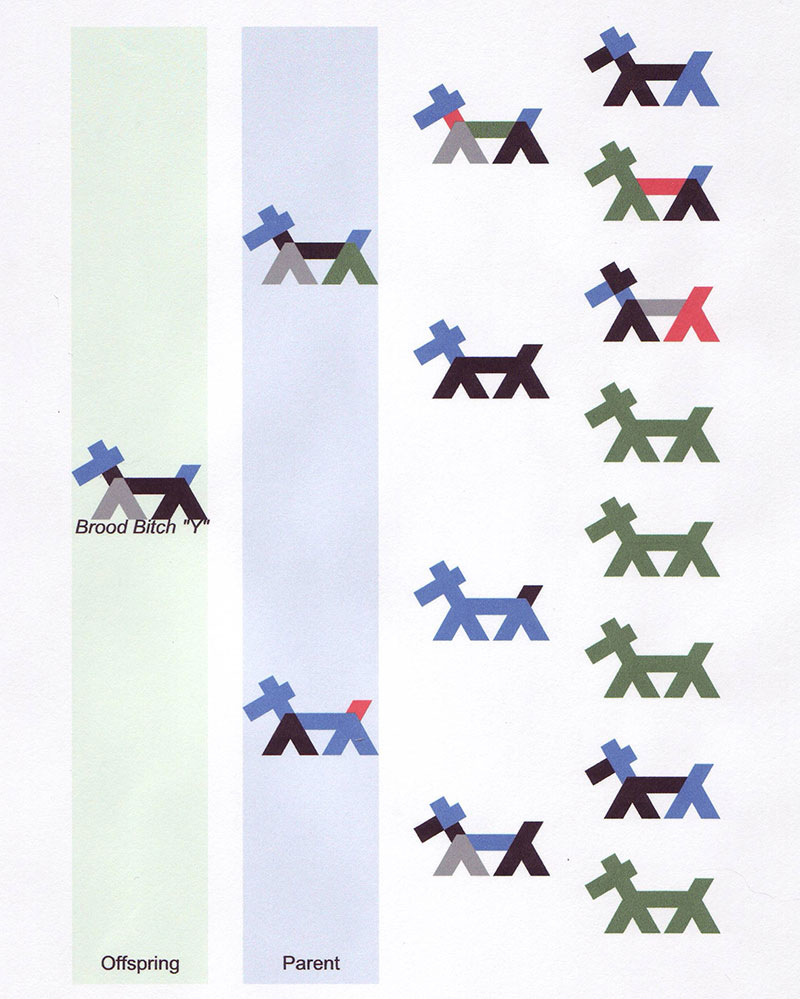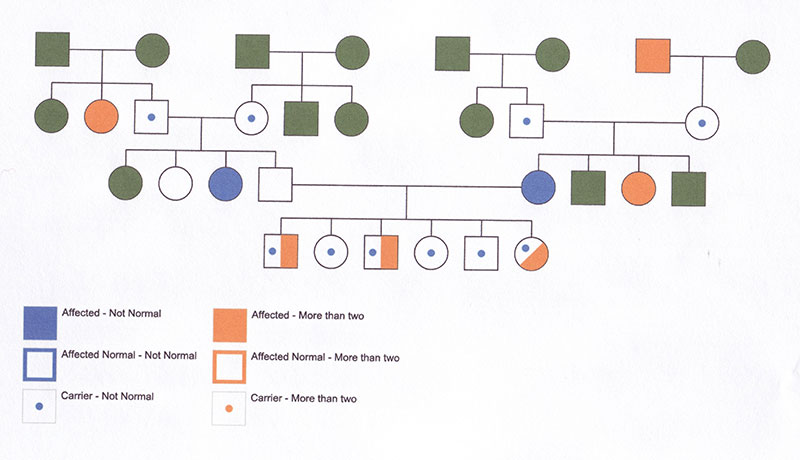Parent Category:
Introduction
The term pedigree is an old word derived from the French "pie de grue", meaning crane's foot. After more than six centuries, the tradition of using the pedigree continues to be the primary breeding tool of breeders based on the logic that when the frequency of a trait or disease occurs among several the ancestors it signals that something is likely to be heritable. The drawn pedigree was first used in the breeding of cattle, sheep, hogs, chickens and other domestic livestock. Over time breeders used it to track the carriers along with the traits for conformation, performance and other important characteristics. Because there were many traits and characteristics of interest to breeders they soon realized that one pedigree would not do the job.
The Pedigree
Historically, the Traditional Pedigree (Figure 1) served as the record that dog breeders used to plan their breedings. Unfortunately it had many limitations. Its most notable shortcoming was the importance it placed on knowing the names, titles and certifications of the ancestors. The custom and use for this pedigree was to recognize and associate names and titles with what could be remembered about each ancestor. Unfortunately this approach lacked reliability and it did not capture the kinds of information needed to make the better breeding decisions. For example, if a breeding combination worked credit would be given to the pedigree and the breeder. But when it didn’t there was no record or source of information to be reviewed. This pedigree did not lend itself to collecting the right kinds of information. Scribbled notes around the edges and in the margins with words such as "beautiful coat", "wonderful type’ etc. or the title or a name of a famous ancestor did not help breeders understand the strengths and weakness of a pedigree and did not help them make better decisions.
Figure 1. Traditional Pedigree
Ch WeLove DuChein's R-Man, ROM OFA
Ch. Kismet's Sight for Sore Eyes ROM, OFA, DNA certified
Ch Kismet’s Sweetheart Deal, ROM, OFA
CH O’Danny Boy of Heinerburg, ROM OFA, and DNA certified
Ch Schokrest San Deigo OFA
OFA Magic Moment of Heinerburg, OFA
Cartel's Amber v Heinerburg, OFA
Puppy "E" Litter
Ch Kismet’s Sight for Sore Eyes, ROM, OFA, and DNA certified
Ch Tindrock-Kaleef Thyme, ROM, OFA, and DNA certified
Ken-Delaine's Katrina, ROM, OFA
Van Cleve's Cassandra v Kaleef, ROM, OFA, and DNA certified
Ch Brier Hill's Storm Buddy, OFA
Ch Kaleef's Blondie, ROM, HS
Ch Hollow Hill's Sierra v Cherpa OFA
While the Traditional pedigree is easy to read, it does not display useful kinds of information. For example, no information is collected about conformation or health and there was no provision that identified the carriers, normals or affected. Breeders of conformation needed specific information about coat, color, eyes, rear, back, front, tail etc. Breeders of working and performance dogs needed other kinds of information about the ancestors. Because the Traditional pedigree used names of dogs, titles, certifications and winning records which are not heritable, breeders had no way to learn from their mistakes. This approach only led to more trial and error breeding which was ineffective as a breeding tool.
Searching the Genotypes
Researchers and breeders often use the term phenotype and genotype. Phenotype refers to the characteristics that can be seen, meaning their external appearance. Thus, a dog that is observed to have a black coat (phenotype) could produce puppies that have coat colors other than black. Such a dog could have a genetic make-up (genotype) that includes the genes for other colors. Those who did not collect and code information usually relied on "type" breedings which involved the breeding of dogs based on their appearances and similarities rather than on the traits produced. Many times "type" breeding simply meant breeding the winners to the winners. In practice, these breedings failed to take advantage of what the science of genetics has taught us about inheritance.
Stickdog Color Chart Pedigree
Breeders soon learned to use another kind of pedigree which could compensate for the limitations of the Traditional Pedigree. Battaglia developed such a pedigree which he called the Stick Dog Color Chart Pedigree. It relied on a vertical approach to pedigree analysis that focused on the depth of a pedigree, meaning the ancestors in the first three generations. This pedigree was originally developed for research and computer analysis.
Coding Traits
The Stick Dog Color Pedigree is used when the breeder’s interest is the strengths and weaknesses of conformation. The logic underlying this pedigree is that each ancestor is drawn as a stick figure (Figure 3) with seven structural parts: ears, head, neck, front, back, rear and tail. Each part is coded using four mutually exclusive colors that signify the quality of each trait based on the Breed Standard. Notes are added to each stick figure to supplement and clarify the color code.
| Color Traits | Rank for Quality |
|---|---|
| Blue | Correct based on breed standard |
| Black | Could be improved based on breed standard |
| REd | Is a fault based on breed standard |
| Grey | Serious fault or disqualification based on breed standard |
| Circle/Green | Missing information or not known |
The rules used to color code quality or the lack there of are straightforward. When a trait is coded with a first place color (blue), it is viewed to be correct or ideal based on the breed standard. For example, if the ears on the sire were correct based on the breed standard they would be color-coded blue. If a trait needed some improvement based on the breed standard it would be color-coded black. Notice in Figure 3 that the ears on the great grandparent are coded black because they could be improved. This same dog also has a faulty rear and tail which are coded red. Color-coding is useful because it seems to identify the range of quality or the strength or weakness of a trait. Coding also shows if there are trends or problems and whether they occur on the sire or dam’s side of the pedigree. Missing information as seen in Figure 3 is shown by the color green as noted in four great grandparents.
Figure 3. Stickdog Pedigree

Notice in Figure 3 that one female was produced and it had a fourth place front as does her father, grandfather, and grandmother on her mother’s side. Thus, in the first two generations, three out of six ancestors, or 50% of her pups’ ancestors, all have the same fourth place front. This suggests that she inherits her faulty front legitimately from her ancestors. Thus color-coding helps the breeder see the location of the strengths and weaknesses in each ancestor.
Symbols Pedigree
Every breeder wants to know what genes are carried by each ancestor for health and performance. Since no single method can look directly into the genotype, breeders must rely on their pedigrees for this kind of information. The best pedigree for this purpose is called the Symbols Pedigree. It focuses on the breadth of a pedigree, meaning the litter-mates. The Symbols Pedigree relies on the logic that a pedigree can be understood by learning about the traits and characteristics observed among the litter-mates of each ancestor. It is especially effective for making improvements in the core elements: health, performance, temperament and other specific traits. It gets its name because symbols, rather than names or stick figures, are used to identify each ancestor. Its great advantage over the Traditional pedigree is that it produces a record that allows a breeder to track and analyze specific health concerns, performance and other special traits of interest.
Coding
The Symbols Pedigree is a powerful tool because of the amount of information that can be coded and quickly analyzed. Unlike the Stick Dog Color Chart pedigree which uses a vertical approach and this pedigree uses a horizontal approach and focuses on the breadth of a pedigree. Coding involves two symbols. Squares are used to represent the males and circles the females. The litter-mates for each ancestor are also included using either a circle or a square. As information is collected about diseases and other characteristics, such as performance, they are coded using a designated color for each trait. If the dog is affected with the disease the symbol is shaded with a specific color. If the dog is a carrier of the disease, a dot of that same color is used. Because breeders are interested in many traits and diseases, several colors will be used in coding this pedigree. The repetition of a color usually signals that a genetic trend may be present.
Figure 3. The Symbols Pedigree
There are several things to notice in Figure 3. The dam of the litter is affected with a disorder (blue) and her symbol is color-coded for the disorder. The breeding produced a litter of six pups (3-3) all of which are carriers as indicated by the blue dot which is the same disorder as found in their mother. Three of the six pups are affected with another disease (orange) that is also found in an aunt (their mother’s sister) a grandmother and a great grandfather. The ancestors coded green indicate that the breeder does not know their status and that the information is missing.

Based on this brief review of the Symbols pedigree it is easy to see how color-codes help the breeder to see the strengths and weakness of a pedigree, which ancestors are affected and which ones are the carriers. Because this kind of information can help to make better breeding decisions it is easy to see that the Traditional Pedigree is less effective as a breeding tool than are the Symbols and Stick Dog Color Chart Pedigrees. A full discussion about coding pedigrees, analysis, formula breeding and stud selections can be found in Breeding Dogs to Win, (Battaglia 2009).
References:
Battaglia, C., 2009. Breeding Dogs to Win, BEI Publications, Atlanta, Georgia. pp. 95-202.
Battaglia, C., 1986. Breeding Better Dogs, BEI Publications, Fifth Printing, Atlanta, Georgia.
Bell, J., 1999. Developing a healthy breeding program, Proceedings. National Parent Club Canine Health Conference, AKC Canine Health Foundation, St. Louis MO. October, pp. 15-17.
Brackett, L., 1961. Planned breeding, Dog World Magazine, Chicago, Ill.
Foley, C., Lasley, J., Osweiler, G., 1979. Abnormalities of companion animals: analysis of heritability, Iowa University Press, Ames, IO.
Hutt, F., 1979. Genetics for Dog Breeders, WH Freeman Co., San Francisco, CA.
Reif, J., 1994. What's in a pedigree? American Kennel Club Gazette, New York, August, Vol. 111, No.8, pp. 30 - 32.
Seranne, A., 1984. The Joy of Breeding Your Own Show Dog, Howell House, New York, N.Y., pp. 51.
Willis, M., 1989. Genetics of the Dog, Howell Book House, New York, NY.
Willis, M., 1999. Breeding better dogs, Key Note Address, Proceedings, National Parent Club Canine Health Conference, AKC Canine Health Foundation, St. Louis, MO., October, pp. 15-17.
About the Author
Carmen L Battaglia holds a Ph.D. and Masters Degree from Florida State University. As an AKC judge, researcher and writer, he has been a leader in promotion of breeding better dogs and has written many articles and several books.Dr. Battaglia is also a popular TV and radio talk show speaker. His seminars on breeding dogs, selecting sires and choosing puppies have been well received by the breed clubs all over the country.

